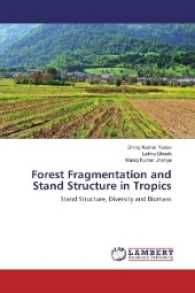- ホーム
- > 洋書
- > 英文書
- > Nature / Ecology
Full Description
The edited volume brings out a comprehensive collection of information relevant to wild food plants, their importance for global sustainable food security, future-readiness, and resilient agriculture. The book's primary focus is to cover topics on the diversity of wild food plants across the globe, their nutraceutical importance, production-consumption trends, integration into the current food menu, and marketing and livelihood opportunities to the indigenous people. Sustainable development goals 1, 2, and 3 are significant for a poverty-free, hunger-free world and ensure good health and wellbeing of the people, respectively. The three goals are important and interlinked as achieving zero poverty will help reduce hunger among the people. Availability of nutritional and balanced food ensures good health. Wild food plants are an essential part of a nourishing and healthy diet for indigenous communities. They are globally collected from natural habitats or cultivated at more minor scales. Although consumed locally, they are an essential part of the diets of tribal and indigenous communities worldwide and hold immense potential to alleviate global hunger. Considering their importance for global sustainable food security, it is essential to clearly understand the future role of wild food plants for future readiness and resilient agriculture. Therefore, this book provides a piece of important information on these aspects. The book is a valuable resource for the audience ranging from undergraduate science students to the NGOs and institutions involved in poverty alleviation programs, policymakers, dieticians, horticulturists, plant breeders, farmers, health experts, and food enthusiasts.
Contents
Chapter 1. Wild food plants for zero hunger and resilient agriculture: An introduction.- Chapter 2. The culture has not faded: reliance on diverse wild edible plants in prehistory, history, and modern times.- Chapter 3. Wild Food Plants: History, Use and Impacts of Globalisation.- Chapter 4. Global traditional food systems that are based on wild food plants.- Chapter 5. Usage of wild edible plants among upland indigenous communities of Northeast India.- Chapter 6. Nutritional and health benefits of high altitude wild food plant, Hippophae rhamnoides for the Himalayan Communities.- Chapter 7. Nutritional potential of wild edible rose hips in India for food security.- Chapter 8. Ethnic mountain foods of Western and Eastern Himalaya, India.- Chapter 9. Reemergence of pseudocereals as super foods for food security and human health: Current progress and future prospects.- Chapter 10. Nutraceutical potential of tropical wild edible plants of India.- Chapter 11. Utilization of wild foodplants for crop improvement programs.- Chapter 12. Conservation of wild food plants and crop wild relatives: planning, strategies, priorities and legal frameworks.- Chapter 13. Databases relevant to wild food plants.- Chapter 14. A comprehensive update on traditional agricultural knowledge of farmers in India.








